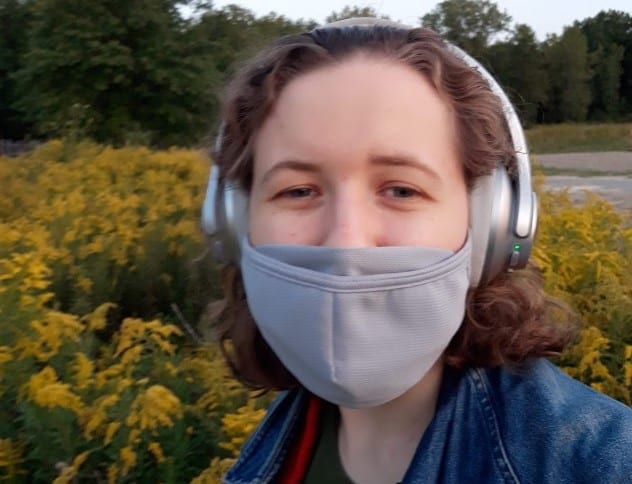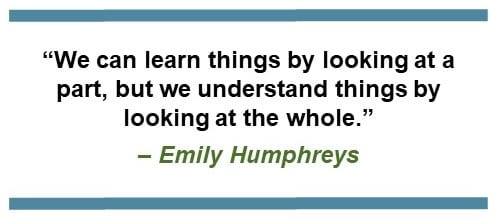News
Summer Intern Blog Week 7: How a Bee is like a Moose

Emily Humphreys enjoys the final week of BTI’s Professional Development Series searching for pollinators.
As I’m writing this, tomorrow is the first day of my final year of college. Even as a senior, I can feel a little bit of nervous anticipation creeping in. There’s so much potential in a beginning. Anything can happen. So much left to learn and so little time to learn it. I want to take every class, but I’ve had to settle for just a few.
The September mornings have begun to take on a slight chill and proper fall frosts won’t be too far behind. Somehow this impossible summer of Zoom meetings, sanitized surfaces, and pajamas-all-day has come to a close. BTI’s Professional Development Series wrapped up several weeks ago now. These last few days of summer have been quiet, and I’ve been able to reflect quite a bit on the things I’ve learned. If you’ll let me, I’d like to share what I’ve been thinking about with you.
—
The final week of BTI’s Professional Development Series featured one talk. Dr Scott McArt from Cornell University’s Department of Entomology spoke to us about his work with pollinators. Much to my surprise, I learned that bee colonies have been shown to struggle more in suburban areas than in conventional agricultural fields. I would have expected heavy pesticide use to lead to the opposite result. It turns out, while pesticides cause significant harm to bees, there are lots of other factors that also affect them. Everything from climate change, to pathogens, to habitat, to land management impact hive success.
In addition, when it comes to pesticides, there is far more nuance than I would have imagined. Different chemicals can have wildly different impacts on pollinators. Dr. McArt introduced us to the concept of synergism. It describes how the level of toxicity caused by a combination of various pesticides, herbicides, and fungicides is often far greater than the sum of the toxicity of each individual chemical. Many times, it’s the combination that makes the chemicals so dangerous for pollinators.
Dr. McArt explained that, in addition to research, much of his job focuses on extension work. Through outreach to beekeepers, growers, policymakers, and the public, he helps ensure that everyone is informed on the latest science surrounding pollinators and pesticides. I had never heard of extension work before, but I could immediately see its value. There is so much important science being done, but its usefulness is limited if knowledge never breaks out of academia. This is one of the reasons I’m interested not only in research but also in science communication. Knowing about extension work has allowed me to imagine futures for myself that I didn’t know were possible before.
A fascinating thing about researching pollination is that it is inherently interdisciplinary. It’s not the study of plants or animals; it’s the study of the interactions between them. Although Dr. McArt gave a talk about insects, he also gave a talk about floral resources, pesticides, agriculture, public policy, and even art. In biology, we tend to study things in isolation – respiration or the model plant Arabidopsis or the flora of Texas – when really everything is so dazzlingly interconnected. We can learn things by looking at a part, but we understand things by looking at the whole.
 The story of how Dr. McArt came to study pollinators highlights how two seemingly distant things can actually share deep connections. Before Dr. McArt studied insects, he studied moose. His research in Alaska focused on what plants moose eat and how the chemical composition of those plants affects their growth. This field of study is called chemical ecology. A near-death experience with a five-foot set of antlers encouraged Dr. McArt to switch his focus from one of the largest animals to one of the smallest. While he remained in the field of chemical ecology, he began to study insects. Just as the toxins in plants impact Moose health, the toxins in pesticides impact pollinator health. Dr. McArt has been helping parse these impacts ever since.
The story of how Dr. McArt came to study pollinators highlights how two seemingly distant things can actually share deep connections. Before Dr. McArt studied insects, he studied moose. His research in Alaska focused on what plants moose eat and how the chemical composition of those plants affects their growth. This field of study is called chemical ecology. A near-death experience with a five-foot set of antlers encouraged Dr. McArt to switch his focus from one of the largest animals to one of the smallest. While he remained in the field of chemical ecology, he began to study insects. Just as the toxins in plants impact Moose health, the toxins in pesticides impact pollinator health. Dr. McArt has been helping parse these impacts ever since.
After each of the talks offered this summer, we had the opportunity to join a breakout room with the speaker to ask them more about their work. Realizing this was my last chance, I seized the opportunity. Over the next 20 minutes, I got to ask Dr. McArt questions about small, understudied pollinators, conducting research in the time of COVID, and taking a gap year before grad school. While hearing all of our speakers present has been wonderful, if there’s one thing remote learning has taught me, it’s that listening to a Zoom lecture is not an effective substitute for conversation. Joining the breakout room was a great opportunity to connect.
—
There was one last surprising connection I made this summer, and it was after the program had ended. I received an email from another student who has been reading my blog posts over the last few months. She explained that she could relate to much of what I have been writing about. A few days later, I met with her in a Zoom meeting, and we discussed our lives as college students, our interest in biology, and our plans for the future. Talking to her and sharing our experiences helped me feel part of a larger plant science community I wasn’t fully aware of before these past few months.
I think if there’s one thing I’ve learned this summer it’s this: Connection is everywhere, and it’s what allows living things to grow and thrive. It’s in apical meristems, conversations with friends, pollination, community forums, community ecology, Zoom meetings, tomato grafts, and nods from across the street.
I am so grateful for the hard work of everyone at BTI that made this program possible. Thanks to them, I have learned about plants, and the process of science, and all the different futures that can stem from the same place. But most of all, I am grateful because, in a summer of intentional isolation, the connections I have made through this program have helped me feel not so alone. Hopefully, through these posts, I have been able to share a little of that with all of you.
Subscribe to BTI's LabNotes Newsletter!
Contact:
Boyce Thompson Institute
533 Tower Rd.
Ithaca, NY 14853
607.254.1234
contact@btiscience.org
Copyright © 2023 | Boyce Thompson Institute | All rights reserved | Privacy Policy | Cookie Policy


